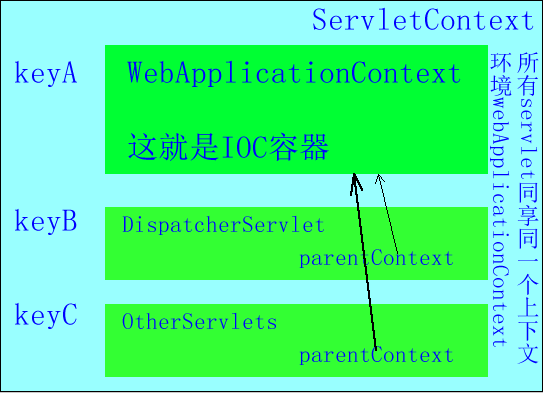Spring-MVC理解之一:应用上下文webApplicationContext
一、先说ServletContext
javaee标准规定了,servlet容器需要在应用项目启动时,给应用项目初始化一个ServletContext作为公共环境容器存放公共信息。ServletContext中的信息都是由容器提供的。
举例:
<context-param> <param-name>key</param-name> <param-value>value123</param-value> </context-param> <listener> <listener-class>com.brolanda.contextlistener.listener.ContextListenerTest</listener-class> </listener>
配置好之后,在该类中获取对应的参数信息
1 2 3 4 5 6 7 8 9 10 11 12 13 14 15 16 17 18 19 20 | package com.brolanda.contextlistener.listener;import javax.servlet.ServletContext;import javax.servlet.ServletContextEvent;import javax.servlet.ServletContextListener;public class ContextListenerTest implements ServletContextListener { public void contextDestroyed(ServletContextEvent event) { System.out.println("*************destroy ContextListener*************"); } @SuppressWarnings("unused") public void contextInitialized(ServletContextEvent event) { System.out.println("*************init ContextListener*************"); ServletContext servletContext = event.getServletContext(); System.out.println("key:"+servletContext.getInitParameter("key")); } } |
执行流程:
web.xml在<context-param></context-param>标签中声明应用范围内的初始化参数
3.容器将<context-param></context-param>转化为键值对,并交给ServletContext.
5.在监听中会有contextInitialized(ServletContextEvent event)初始化方法
二、spring上下文容器配置
spring为我们提供了实现ServletContextListener接口的上下文初始化监听器:org.springframework.web.context.ContextLoaderListener
spring为我们提供的IOC容器,需要我们指定容器的配置文件,然后由该监听器初始化并创建该容器。要求你指定配置文件的地址及文件名称,一定要使用:contextConfigLocation作为参数名称。
<context-param>
<param-name>contextConfigLocation</param-name>
<param-value>/WEB-INF/applicationContext.xml,/WEB-INF/action-servlet.xml,/WEB-INF/jason-servlet.xml</param-value>
</context-param>
<listener>
<listener-class>org.springframework.web.context.ContextLoaderListener</listener-class>
</listener>
该监听器,默认读取/WEB-INF/下的applicationContext.xml文件。但是通过context-param指定配置文件路径后,便会去你指定的路径下读取对应的配置文件,并进行初始化。
三、spring上下文容器配置后,初始化了什么?
既然,ServletContext是由Servlet容器初始化的,那spring的ContextLoaderListener又做了什么初始化呢?

对于作用范围而言,在DispatcherServlet中可以引用由ContextLoaderListener所创建的ApplicationContext中的内容,而反过来不行。
四、spring配置时:<context:exclude-filter>的使用原因,为什么在applicationContext.xml中排除controller,而在spring-mvc.xml中incloud这个controller




【推荐】编程新体验,更懂你的AI,立即体验豆包MarsCode编程助手
【推荐】凌霞软件回馈社区,博客园 & 1Panel & Halo 联合会员上线
【推荐】抖音旗下AI助手豆包,你的智能百科全书,全免费不限次数
【推荐】轻量又高性能的 SSH 工具 IShell:AI 加持,快人一步
· 深入理解 Mybatis 分库分表执行原理
· 如何打造一个高并发系统?
· .NET Core GC压缩(compact_phase)底层原理浅谈
· 现代计算机视觉入门之:什么是图片特征编码
· .NET 9 new features-C#13新的锁类型和语义
· Sdcb Chats 技术博客:数据库 ID 选型的曲折之路 - 从 Guid 到自增 ID,再到
· 语音处理 开源项目 EchoSharp
· 《HelloGitHub》第 106 期
· Spring AI + Ollama 实现 deepseek-r1 的API服务和调用
· 使用 Dify + LLM 构建精确任务处理应用